

NPPC voices concerns over swine industry visa decisions
“…Created under the North American Free Trade Agreement, the TN visa allows Canadian and Mexican professionals to temporarily fill specific job openings in the United States. It is used widely in the swine industry as a way to source qualified and competent labor for farm jobs.
NPPC has received reports that eligible applicants have been denied entry into the country for no cause and cannot appeal such decisions. Other evidence suggests applicants have been rejected because of subjective interpretations of having “sufficient ties” to their home country and about their intent to return to it. The NPPC reports that in one case, a veterinarian with a clinic in Mexico was denied a TN visa and told the decision was final…”
https://www.thepigsite.com/news/2021/10/nppc-voices-concerns-over-swine-industry-visa-decisions
Force for Good
“…The still surging COVID-19 crisis has disproportionately affected marginalized communities nearly anywhere you look. That disparity is marked in northern Santa Barbara County, where a vast majority of positive cases have been recorded among its populations of Indigenous migrants and undocumented residents.
The Latinx and Indigenous Migrant COVID-19 Response Task Force —conceived by Dr. Van Do-Reynoso, director of the Santa Barbara County Department of Public Health, and helmed by physician Melissa Smith, director of health equity initiatives at UC Santa Barbara — is working to help these individuals by focusing on their experiences, health education and equitable treatment in the face of the pandemic…”
Latino businesses have been hit hard by the pandemic. But owners won’t give up hope
“Maria Palacio had made it.
She grew up on a coffee farm in Colombia. She knew how little money coffee farms and their workers made. When she came to the U.S. in 2010, she wanted to change that, so she founded Progeny Coffee in Palo Alto to help bring growers out of poverty.
Soon, she began supplying Google, Facebook, Microsoft and LinkedIn, providing coffee for the tech companies’ huge campuses, which allowed her to bring awareness to the coffee farmers she started all of this for.
Then tech companies began sending workers home, closing their campuses in Silicon Valley and their towers in San Francisco in the weeks before the coronavirus was officially declared a pandemic. Sales at the company, now based in Berkeley, dropped by 97% after shelter-in-place hit, Palacio said…”
Mexico’s coronavirus-skeptical president is setting up his country for a health crisis
“…As Mexico fast approaches what’s highly likely to be a large coronavirus outbreak, the country’s leadership — mainly its president — mostly insists that everything is fineIn speech after speech, President Andrés Manuel López Obrador, known by his nickname AMLO, tells Mexicans they shouldn’t fear Covid-19, even as hundreds of thousands of people have confirmed infections worldwide. Despite warnings from global health officials, he continues to hold political rallies, kiss supporters, and request that Mexicans go out shopping to prop up the country’s sputtering economy during a global slowdown.“Live life as usual,” he said in a video posted to Facebook on March 22, showing him outside at a restaurant. “If you’re able and have the means to do so, continue taking your family out to eat … because that strengthens the economy.”…”
https://www.vox.com/2020/3/26/21193823/coronavirus-mexico-andres-manuel-lopez-obrador-health-care
Coronavirus layoffs disproportionately hurt black and Latino workers: ‘It’s almost like doomsday is coming’
“People at an economic disadvantage are “already not doing so great in a good day, let alone in a rainy day,’’ he said.Jose Ricardo is already bracing to dip into his savings to pay next month’s bills for his mobile home in Chula Vista, California. Ricardo, a waiter at a Japanese restaurant in San Diego, is working only 16 hours a week, down from the usual 32 hours two weeks ago.“I’m really nervous,’’ said Ricardo, 61. “We are used to working hard.”With new restrictions on restaurants to serve takeout only, Richardo no longer has the extra income from tips. He makes $12 an hour.“People pay tips because they get a service. We’re taking care of them,’’ he said. “Now, with takeout, they pick it up and bye-bye.”
Ricardo, who lives with his wife, mother-in-law and two children, said he’s anxiously waiting to see how lawmakers will help him and other workers.
He’s holding out hope. “We will recover for sure,” he said…”
American farms recruit Mexican veterinarians for jobs as animal scientists — but the real work is milking cows and cleaning pens for low pay
“Leslie Ortiz had just graduated when a recruiter arrived at her Mexico City university looking for veterinarians to work on an Idaho dairy farm.
It appeared to be an opportunity to gain experience, learn English, pay down credit card debt from her time as a student and even start to save.
The offer came with a visa — one issued through a special program for professionals from Mexico and Canada who are needed for high-skilled jobs in the U.S.
When Ortiz, then 26, learned she got the job — an animal scientist at Funk Dairy — she was thrilled. To pay for her flight to Idaho, she borrowed $150 from family and pawned her jewelry, including a gold chainlet with the image of the Virgin of Guadalupe she received on her 15th birthday…”
Link to article
On the US-Mexico Border, Craft Beer Diplomacy Is Bringing Brewers Together
‘Sick of battling it out on southern California’s legendarily congested freeways, Ryan Brooks packed his bags and headed south. “I was living about an hour north of San Diego, commuting an hour each way, and I thought, ‘This is stupid, I hate it,’” he said. “So I went to TJ and spent 100 bucks a month to stay at my buddy’s house.”
That’s “TJ” as in Tijuana, Mexico, a breezy 15- to 20-minute drive from Coronado Brewing Co., where Brooks was working as a brewer in 2011. “The same border guy waved me through every day because I was like the one white guy crossing [from Mexico into the US] at 5 in the morning,” he remembered…”
Link to article
Founders of tortilla company hope to eventually sell food to UCLA Dining
“…Ronald Alcazar spent years honing his family’s tortilla recipe with his mother for he and his brother’s new tortilla company. Today, the two UCLA alumni have their own tortilla factory and hope to sell their tortillas to UCLA Dining Services.
Anthony and Ronald Alcazar, who graduated from UCLA in 2006 and 2012 respectively, started their own flour tortilla company, Mr. Tortilla, in 2012. Anthony Alcazar said he urged his brother to start the company during Ronald Alcazar’s senior year of college because they wanted to share their family’s tortilla recipe.
Developing the tortilla recipe was a family endeavor, Ronald Acazar said. He spent over a year creating the formula with his mother and father. He said he prides Mr. Tortilla tortillas on being non-GMO and preservative-free…”
Latino Food Industry Association launches
LOS ANGELES — The Latino Food Industry Association (LFIA) announced its official launch to serve its members and educate the public and policy makers on the contributions and significant impact made buy Latino-owned food businesses on the US economy.
“Given the Hispanic market’s $1.5 trillion in annual buying power and the rapid growth of Hispanic-owned businesses in the food and beverage segment, many of our members felt it was time to launch the LFIA to maximize our position in the industry,” said Ruben Smith, LFIA chairman. “Our members include grocery chains…
Link to article
How I Made It From teen immigrant to vintner, Rolando Herrera has bottled his dream
Rolando Herrera runs Mi Sueño Winery in Napa Valley, which annually produces about 8,000 to 10,000 cases of premium estate Chardonnay, Pinot Noir, Syrah, Cabernet Sauvignon, Malbec, Petit Verdot and a specialty blend. The family-run operation, Spanish for “My Dream,” has 16 full-time employees and 40 acres of vineyards — with another 23 planned…
Link to article
Mexican migrant workers came to California to pick grapes. Now they own wineries.
The Smithsonian recognizes five families who have worked their way up in the U.S. wine industry
Outside Robledo Family Winery, south of Sonoma, on a cool April Sunday, the U.S. and Mexican flags whipped a stiff salute in the wind blowing off the San Pablo Bay. A third banner bore the winery logo. The flags represent three themes central to the lives of Reynaldo Robledo and many other Mexican migrant workers who have helped shape California’s wine industry: heritage, opportunity and family…
Link to article
Anthony Bourdain’s ‘Parts Unknown’ Takes a Deep Look at Los Angeles’ Mexican Food Scene
Anthony Bourdain took his love of food, culture, and conversation back to Los Angeles for season nine of CNN’s Parts Unknown. Over the course of several shows, Bourdain has done more than a few episodes in the City of Angels, but this time he focuses his lens on Latinos.
“What if we look at LA from the point of view of the largely unphotographed – the 47 percent of Angelenos who don’t show up so much on idiot sitcoms and superhero films?” Bourdain asked in voiceover. The former chef/current TV host gorged on Tacos Indiana 2 Taco Stand‘s pastor and lengua offerings, mole at Gish Bac Restaurant, camarones borrachos at Mariscos Chente, and Cielito Lindo‘s famous taquitos…
Link to article
Trump puts U.S. food, farm companies on edge over Mexico trade
By Tom Polansek and Mark Weinraub | CHICAGO
U.S. food producers and shippers are trying to speed up exports to Mexico and line up alternative markets as concerns rise that this lucrative business could be at risk if clashes over trade and immigration between the Trump administration and Mexico City escalate.
Diplomatic relations have soured fast this month, as the new U.S. administration floated a 20 percent tax on Mexican imports and a meeting between the presidents of the two countries was canceled. U.S. President Donald Trump has also pledged to renegotiate the North American Free Trade Agreement (NAFTA) trade deal with Mexico and Canada…
Link to article
République’s new wine director is now one of the most influential Latina sommeliers in the country
On the second day of January, Taylor Parsons, chief author of one of the most dynamic wine lists in Los Angeles, left his position at République — that day, by his calculation, represented his 1,000th evening menu at the celebrated Hancock Park bistro. He plans to spend the next year developing a restaurant project he can call his own, consulting, and helping his wife Briana Valdez expand her own business, the Loz Feliz Tex-Mex joint HomeState.
He left the wine program in the hands of 33-year-old Maria Garcia, who instantly becomes one of the most important wine directors in the city, and one of the most influential Latina sommeliers in the country.
Garcia is an L.A. native raised in Whittier. She was set on taking her history and political science degrees from UCLA into a career in education — in fact, she was teaching at a high school in Crenshaw when her interest in wine and cocktail culture drew her back toward..
Link to article
Mexican American Proarchive: Annual Report on Mexican American Professionals
News from the census American Community Survey is generally good for the 2015 year. Mexican American college enrollment was up from 18.7% to 18.9% in the 2014 and 2015 years. Graduate or professional degree attainment was also up from 2.9% to 3.0%. The number of bachelor’s degrees granted to Mexican American students rose from 7.6% in 2014 to 7.8% in 2015.


In spite of these gains, Mexican Americans still remain at the bottom of the ladder when it comes to earning a bachelor’s degree. Even after broadening the group to Latinos or Hispanics, this group still lags behind. According to the Pew Hispanic Center: “As of 2014, among Hispanics ages 25 to 29, just 15% of Hispanics have a bachelor’s degree or higher. By comparison, among the same age group, about 41% of whites have a bachelor’s degree or higher (as do 22% of blacks and 63% of Asians).” Pew reports that the main reasons for this low graduation rate is that Hispanics are less likely “to enroll in a four-year college, attend an academically selective college and enroll full-time.”
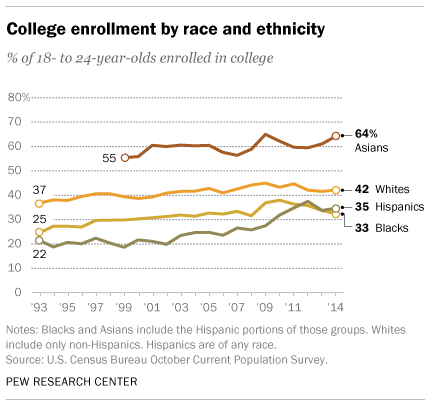
Also in the good news column, the University of California will continue to push for a greater number of underrepresented minorities; namely, Chicano/Latino students whose resident freshmen numbers rose from 2.7% to 32.3% of admitted California freshmen. In other good news, the proportion of Chicano/Latino students transferring from community colleges increased to 29.3% from 26.8% for 2015.
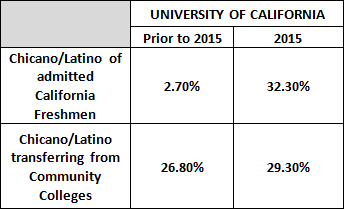
Occupations, including those in management, business, science, and art, fared better for Mexican Americans. The number of Mexican Americans filling these occupations rose from 17.4% in 2014 to 17.5% in 2015.

The total number of Hispanics filling these occupations was 16.1% in 2015, a bit lower than Mexican Americans specifically.
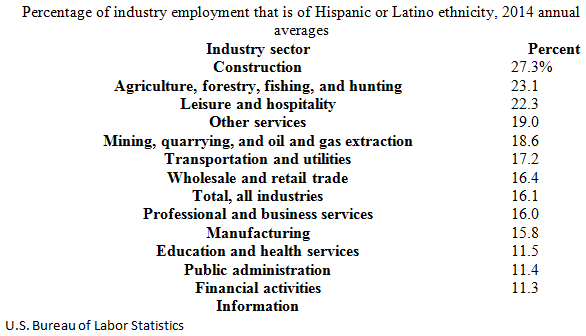
The report shows that industrial employment for Mexican Americans remained the same for 2014 and 2015 at 10.2%.
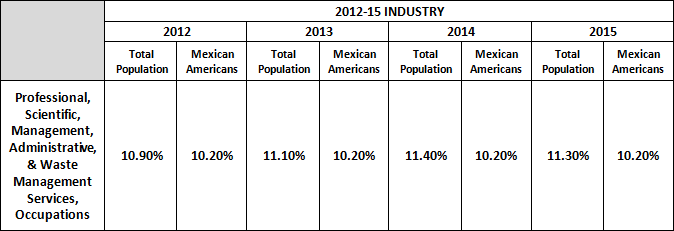
The figures for Hispanic or Latino employment for 2015 and 2016 show a healthy increase.
According to the Pew Hispanic center, “Construction, professional and business services, health services, financial services and food services…showed healthy gains.” Most of the jobs gained by native-born Hispanic workers were in manufacturing, mostly durable goods (82,000 Hispanic workers in this industry), followed by wholesale and retail trade (79,000), publishing, broadcasting, communication and information services (55,000), and construction (54,000).
Foreign-born Hispanics had the most job gains in construction (417,000), followed by business and professional services (179,000). Together, those two industries accounted for almost three-quarters (74%) of all jobs gained by foreign-born Latinos between 2005 and 2006.
The business and professional services sector, which ranges from management and technical services to janitorial, landscaping, and waste management services, is also a key employer for non-Hispanic workers. Of the total increase in employment in 2005-06, non-Hispanic workers accounted for 410,000 employees in the industry, native-born workers 327,000, and foreign-born workers 83,000.
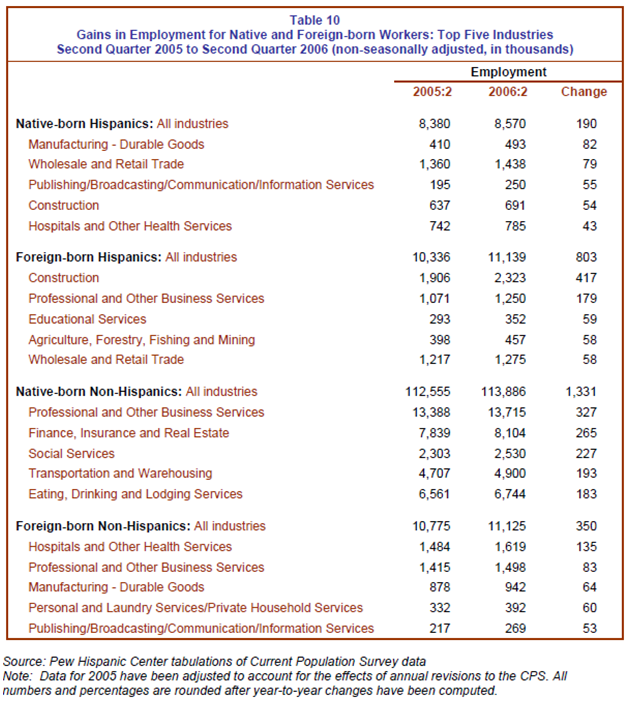
Sources
- Census Bureau, Selected Population Profile in the United States: 2015
- Pew Research Center
- University of California
- Bureau of Labor Statistics
Award-Winning Chef Pati Jinich Touts Mexico’s Varied, Evolving Flavors
Sometimes the hardest thing to do is just be yourself. It was a risk Pati Jinich, the D.C.-based Mexican- born chef, best-selling cookbook author and television host decided to take when she went off script for her popular PBS series Pati’s Mexican Table. It had been on the air for a couple of years when a new production company meant an entirely new direction…
Link to article
Food in the Gilded Age: What ordinary Americans ate
Mexican American Diets,Las Cruces, Spring 1896 … Fall through Early Spring, 1901–1903 Typical Winter–Spring Diet,
Tuskegee, 1895–1896 Typical Winter Diet, Poor African Americans, Philadelphia and …
Link to book preview
Intergenerational Influences in Body Image Among Mexican American Obese Adolescent Females and Their Maternal Caregivers: ¿ Llenita no más ?
YA Marroquin
… Grounded Theory and thematic analysis were utilized to examine interview responses from
Mexican and Mexican American adolescent females with obesity, their … family members, peers
and friends, and medical professionals). In addition, the messages …
Link to dissertation
Eating Together, Separately: Intergroup Communication and Food in a Multiethnic Community
A Wenzel – International Journal of Communication, 2016
… feeling ‘other.’ And you feel like your neighborhood is being invaded by people who are other
‘other’—and they seem to be the ones that everybody’s interested in.” He said he’s seen similar
divisions before, such as between African Americans and Mexican immigrants in …
Link to study
The Perceptions, Knowledge , Benefits and Barriers of Hispanics Regarding the Dietary Guidelines for Americans
LDA Gamboa – 2015
… 2005). However, the San Antonio Heart Study contradicted this paradox, showing
that Mexican- Americans indeed had a higher risk of cardiovascular and coronary
diseases than did non-Hispanic Whites (Hunt et al., 2003). …
Link to thesis


